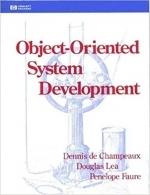Object-Oriented System Development by Dennis deChampeaux, Doug Lea, Penelope Faure

Категория: Other
Поделиться:
Object-oriented (OO) programming has a growing number of converts. Many people believe that object orientation will put a dent in the software crisis. There is a glimmer of hope that OO software development will become more like engineering. Objects, whatever they are now, may become for software what nuts, bolts and beams are for construction design, what 2-by-4s and 2-by-6s are for home construction, and what chips are for computer hardware construction.
However, before making this quantum leap, object-orientedmethods still have to prove themselves with respect to more established software development paradigms. True, for small tasks the war is over. Object-oriented programs are more compact than classic structured programs. It is easier to whip them together using powerful class libraries. Inheritance allows "differential programming", the modification in a descendant class of what is wrong with a parent class, while inheriting all of its good stuff. User interfaces, which are often sizable fractions of small systems, can be put together easily from object-oriented libraries.
Delivering large object-oriented software systems routinely and cost effectively is still a significant challenge. To quote Ed Yourdon: "A system composed of 100,000 lines of C++ is not to be sneezed at, but we don't have that much trouble developing 100,000 lines of COBOL today. The real test of OOP will come when systems of 1 to 10 million lines of code are developed."
Скачать
Комментарии